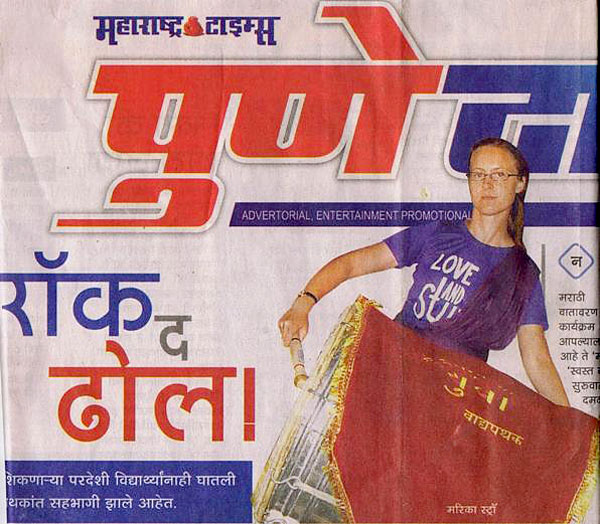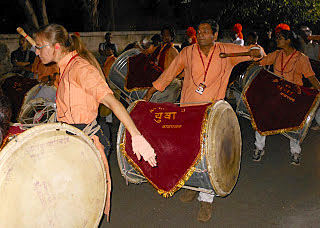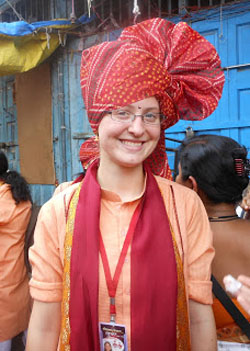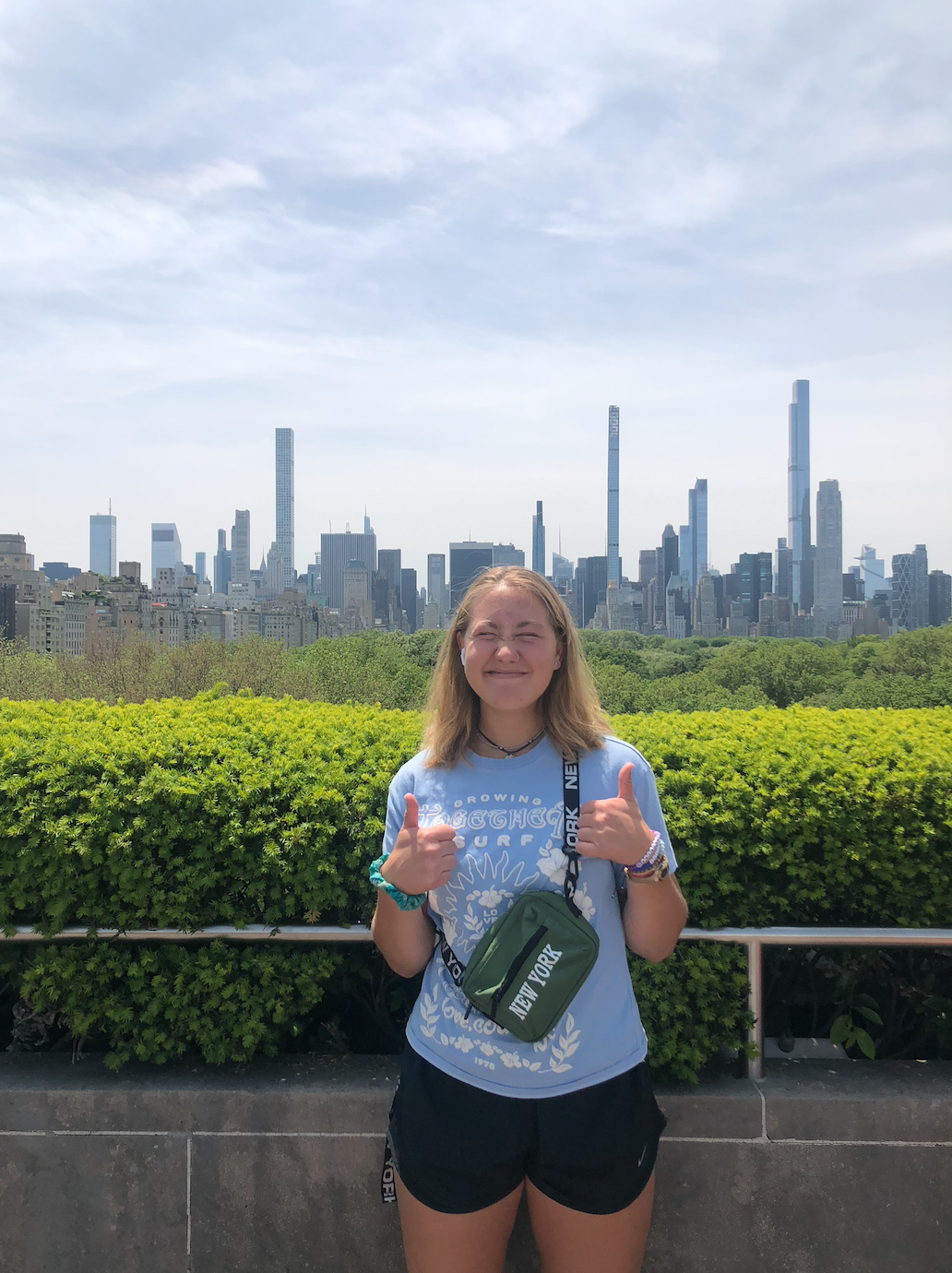“It’s an enormously huge sound,” Marika Straw recalled. “When you’re in the middle of it, you just feel like you’re in the middle of something bigger than yourself. That feeling is really amazing.”
A Lawrence University senior, Straw participated in ACM’s India: Culture, Traditions, & Globalization program this past fall. While there, she had a rare opportunity – certainly for a foreign student – to join a pathak, one of the drumming groups that made daily processions through the crowded streets of Pune during the ten-day Ganapati Festival in late September.
 Marika Straw in the Maharashtra Times. (Photos are courtesy of Marika Straw)
Marika Straw in the Maharashtra Times. (Photos are courtesy of Marika Straw)
It proved to be a challenging and powerful experience, through which Straw made friends and gained insights into Indian culture, as well as herself. She also became a local celebrity, when she and her drum were prominently featured in the Maharashtra Times, one of India’s largest-selling newspapers.
Drumming up a measure of fame
The ACM students arrived in Pune in mid-August and after a few days settled in with their host families. For Straw, her host family was one of the highlights of the program. Living with them was fortuitous in another way, too, as their house was close to an area along the river where pathake (the plural of pathak) practiced.
“You could not escape the sound of them, basically from when we arrived until the festival was over, so for about a month,” said Straw. “So I heard them, and being a musician, I was curious.”
When Straw found out that her host cousin and sister were in a pathak, she was determined to join and insisted on playing the dhol, the large bass drum that the drummers carried tied to their waists. In procession, the drumming group was dominated by dhols and tashas (snare drums), along with zhans (small, handheld cymbals with yellow streamers) and a solitary, large gong on wheels, called a tol.
 Marika Straw with her host grandfather.
Marika Straw with her host grandfather.
Marching with the drummers was a dhwaj, an ensemble of dancers and a saffron-colored flag that was gradually unfurled as the group moved, releasing flower petals wrapped up in the cloth.
The drumming practices were grueling – two hours each evening, at a minimum, which expanded as the festival approached. It was during that time that the Maharashtra Times ran an article about foreigners in pathake, topped by the photo of Straw, and her friends gave her clippings from other newspapers that carried her photo.
Once Ganapati kicked off with the pathak‘s first procession, or mirownuk, the group took to the city’s streets at least once nearly every day of the festival. In vivid detail, Straw described the scene in her blog. (Note: This excerpt and those that follow are from her blog post on October 8, 2012.)
Then, out of the general hubbub, I hear the sound of one tasha trilling, trilling, the beginning of something truly beautiful and magnificent arising out of seeming chaos. Concentration seems to focus in on this one sound amidst the traffic noise, the bustle of the crowd watching, the flock of birds flying circles around the tree across the street. Trills, trills, trills, trills, and then finally, the first stroke of the dhols, and the flag rises up and comes down triumphantly, beginning to slowly unfurl. A few red flower petals delicately float to the ground. The mirownuk has begun.
The world’s biggest Ganapati Festival
Ganapati is an annual Hindu religious festival honoring Ganesh, the elephant-headed god who stands for overcoming obstacles, among other things. Pune is at the epicenter of the Ganesh festival, according to Straw, and it’s where the public celebration of the festival got its start. “They have the biggest celebration of Ganapati in the world – bigger than Mumbai, bigger than anyplace else in India,” she said.
 The pathak, and Marika Straw, in action.
The pathak, and Marika Straw, in action.
“You can’t escape it for ten days,” Straw explained. “The processions just take over major public streets and totally mess up traffic and are deafening. Platforms go up everywhere with Ganapati idols on them, these enormous 15 feet by 15 feet by 15 feet stages erected with corrugated tin roofs and bamboo supports.”
Fascinated, Straw chose the festival as the topic of her independent study project. She found that pathake traditionally were almost entirely made up of boys and men, often based on school affiliations. In recent years, though, many of the groups have been community-based, and girls and women are increasingly involved. Straw’s pathak made a practice of welcoming members of all ages and all walks of society, and was fairly evenly split between males and females.
Overall, Straw said, there are 80 drumming groups registered with the pathak association in Pune, each boasting anywhere from 100 to 500 members, plus other unregistered groups. Thousands and thousands of people participated in Ganapati processions.
There is give and take, there is flexibility, there is an overriding structure, a rhythm one could say, to this chaos which is not really chaos at all. A rope is passed down the line of people protecting the pathak from the road traffic, and motorcycles and even cars are able to pass. Huge, ancient, lumbering city buses packed with people squeeze by and small boys and girls lean out of the buses’ windows, admiring. They are within inches of the pathak members encircling the ensemble, yet no one gets hurt. At times the group stops to let vehicles through. We are flexible. Whatever happens, we adjust to make it work. We are a living, breathing organism.
Pathake and a changing society
During the fall, after Ganapati was over, Straw interviewed people in her pathak for her project. She explored how the pathake cause change to occur in Pune society as well as reflect social changes that are taking place, particularly related to the musical culture of the festival, women in pathake, and the demographics of pathake.
She found that over the past decade there’s been a movement in the festival’s music – with a renewed emphasis on the drumming – to revive tradition and the holy aspects of Ganapati. At the same time, though, change has been afoot.
Maharashtra, where Pune is located, has a centuries-old tradition of armies using drumming for inspiration as they go into battle and to celebrate victories, so the addition of girls and women to the pathake in recent years has been significant, Straw said.
 Clipping of an article about Marika Straw presenting her project on pathake. With her is ACM India Program Director Sucheta Paranjpe. View a larger image.
Clipping of an article about Marika Straw presenting her project on pathake. With her is ACM India Program Director Sucheta Paranjpe. View a larger image.
“Symbolically, you put a drum in a woman’s hand and you’re giving her more power,” she noted. “Also, [females are] being allowed to be out on the street without their relatives, and being allowed to be out on the street at night, because nearly all of the processions were at night. These were all huge changes from the past, and it gave [girls and women] a lot of confidence.”
As Straw was completing her project, people she knew in the pathak asked her to present her findings publicly. “A few of the leaders [of the group] were doing a documentary on pathake, so they were very interested in what I had to say and what I had discovered from doing interviews,” she said.
At a formal event before an appreciative audience, she gave her presentation and received gifts, including an artist’s sketch of Straw in her pathak uniform. They also invited her back for this year’s Ganapati Festival and to speak at a conference on pathake in August. Her presentation also sparked another flurry of newspaper articles.
After returning to Lawrence in January, Straw was accepted to present her research on pathake at the Midwest Chapter of the Society for Ethnomusicology Conference in April.
Standing around in between bouts of drumming, I am so exhausted that I long for someone to appear and remove my drum, but still too bewildered and overcome by it all to ask someone to take it. Instead, I squat and rest my head on the top of my dhol. “You tired?” someone asks, and I can barely manage a reply, but even through my exhaustion I have never been as present as I am at this moment.
 Wearing traditional pathak garb.
Wearing traditional pathak garb.
You’re my friend, don’t leave!
“It was, hands down, one of the most challenging things I’ve ever done in my life,” Straw said in summing up her experience in the pathak. “It took considerable will power and physical and mental and moral strength. It was two hour practices every night for three weeks, often longer than that, and also the drumming during the festival, and a lot of not knowing what was going on…. I learned how to deal with that, which made me a stronger and more independent person.”
In the course of conducting interviews for her project, Straw said, she learned to listen well, to think about the context and nuances of what she was being told, and – perhaps most importantly – to refrain from interjecting her own reactions or opinions during the interviews. In the end, she said, she gained a deeper understanding of the culture and the people she interviewed, and also earned a measure of their respect for listening and learning.
Straw also made a lot of friends in the pathak, which enriched her experience on the India Program. “They were people my age, and that made a huge difference,” she said. “I hung out with my family all the time, but they weren’t my age. It was really interesting meeting other people who were my age. By the end, they were saying, ‘You’re my friend, don’t leave!'”
After years engaged in the battle of finding complete happiness in life, at least for this moment, I have won. The drums create a resounding victory.
Links:
India: Culture, Traditions, & Globalization
Marika Straw’s blog about her experience in India









